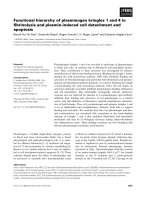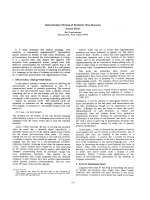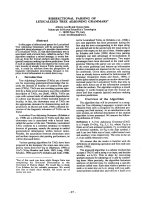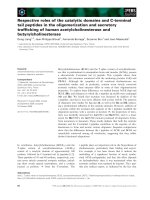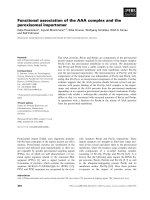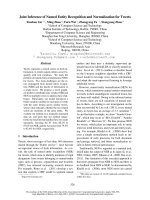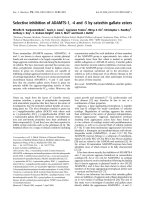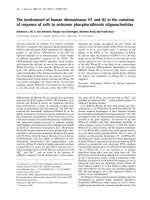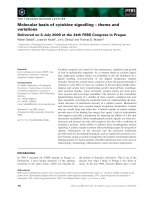Báo cáo khoa học: "Dependency Parsing of Hungarian: Baseline Results and Challenges" potx
Bạn đang xem bản rút gọn của tài liệu. Xem và tải ngay bản đầy đủ của tài liệu tại đây (137.66 KB, 11 trang )
Proceedings of the 13th Conference of the European Chapter of the Association for Computational Linguistics, pages 55–65,
Avignon, France, April 23 - 27 2012.
c
2012 Association for Computational Linguistics
Dependency Parsing of Hungarian: Baseline Results and Challenges
Rich
´
ard Farkas
1
, Veronika Vincze
2
, Helmut Schmid
1
1
Institute for Natural Language Processing, University of Stuttgart
{farkas,schmid}@ims.uni-stuttgart.de
2
Research Group on Artificial Intelligence, Hungarian Academy of Sciences
Abstract
Hungarian is a stereotype of morpholog-
ically rich and non-configurational lan-
guages. Here, we introduce results on de-
pendency parsing of Hungarian that em-
ploy a 80K, multi-domain, fully manu-
ally annotated corpus, the Szeged Depen-
dency Treebank. We show that the results
achieved by state-of-the-art data-driven
parsers on Hungarian and English (which is
at the other end of the configurational-non-
configurational spectrum) are quite simi-
lar to each other in terms of attachment
scores. We reveal the reasons for this and
present a systematic and comparative lin-
guistically motivated error analysis on both
languages. This analysis highlights that ad-
dressing the language-specific phenomena
is required for a further remarkable error re-
duction.
1 Introduction
From the viewpoint of syntactic parsing, the lan-
guages of the world are usually categorized ac-
cording to their level of configurationality. At one
end, there is English, a strongly configurational
language while Hungarian is at the other end of
the spectrum. It has very few fixed structures
at the sentence level. Leaving aside the issue of
the internal structure of NPs, most sentence-level
syntactic information in Hungarian is conveyed
by morphology, not by configuration (
´
E. Kiss,
2002).
A large part of the methodology for syntactic
parsing has been developed for English. How-
ever, parsing non-configurational and less config-
urational languages requires different techniques.
In this study, we present results on Hungarian de-
pendency parsing and we investigate this general
issue in the case of English and Hungarian.
We employed three state-of-the-art data-driven
parsers (Nivre et al., 2004; McDonald et al., 2005;
Bohnet, 2010), which achieved (un)labeled at-
tachment scores on Hungarian not so different
from the corresponding English scores (and even
higher on certain domains/subcorpora). Our in-
vestigations show that the feature representation
used by the data-driven parsers is so rich that they
can – without any modification – effectively learn
a reasonable model for non-configurational lan-
guages as well.
We also conducted a systematic and compar-
ative error analysis of the system’s outputs for
Hungarian and English. This analysis highlights
the challenges of parsing Hungarian and sug-
gests that the further improvement of parsers re-
quires special handling of language-specific phe-
nomena. We believe that some of our findings
can be relevant for intermediate languages on the
configurational-non-configurational spectrum.
2 Chief Characteristics of the
Hungarian Morphosyntax
Hungarian is an agglutinative language, which
means that a word can have hundreds of word
forms due to inflectional or derivational affixa-
tion. A lot of grammatical information is encoded
in morphology and Hungarian is a stereotype of
morphologically rich languages. The Hungarian
word order is free in the sense that the positions
of the subject, the object and the verb are not fixed
within the sentence, but word order is related to
information structure, e.g. new (or emphatic) in-
formation (the focus) always precedes the verb
55
and old information (the topic) precedes the focus
position. Thus, the position relative to the verb
has no predictive force as regards the syntactic
function of the given argument: while in English,
the noun phrase before the verb is most typically
the subject, in Hungarian, it is the focus of the
sentence, which itself can be the subject, object
or any other argument (
´
E. Kiss, 2002).
The grammatical function of words is deter-
mined by case suffixes as in gyerek “child” – gye-
reknek (child-DAT) “for (a/the) child”. Hungarian
nouns can have about 20 cases
1
which mark the
relationship between the head and its arguments
and adjuncts. Although there are postpositions
in Hungarian, case suffixes can also express re-
lations that are expressed by prepositions in En-
glish.
Verbs are inflected for person and number and
the definiteness of the object. Since conjugational
information is sufficient to deduce the pronominal
subject or object, they are typically omitted from
the sentence: V
´
arlak (wait-1SG2OBJ) “I am wait-
ing for you”. This pro-drop feature of Hungar-
ian leads to the fact that there are several clauses
without an overt subject or object.
Another peculiarity of Hungarian is that the
third person singular present tense indicative form
of the copula is phonologically empty, i.e. there
are apparently verbless sentences in Hungarian:
A h
´
az nagy (the house big) “The house is big”.
However, in other tenses or moods, the copula
is present as in A h
´
az nagy lesz (the house big
will.be) “The house will be big”.
There are two possessive constructions in
Hungarian. First, the possessive relation is only
marked on the possessed noun (in contrast, it is
marked only on the possessor in English): a fi
´
u
kuty
´
aja (the boy dog-POSS) “the boy’s dog”. Sec-
ond, both the possessor and the possessed bear a
possessive marker: a fi
´
unak a kuty
´
aja (the boy-
DAT the dog-POSS) “the boy’s dog”. In the latter
case, the possessor and the possessed may not be
adjacent within the sentence as in A fi
´
unak l
´
atta a
kuty
´
aj
´
at (the boy-DAT see-PAST3SGOBJ the dog-
POSS-ACC) “He saw the boy’s dog”, which results
in a non-projective syntactic tree. Note that in
the first case, the form of the possessor coincides
1
Hungarian grammars and morphological coding sys-
tems do not agree on the exact number of cases, some rare
suffixes are treated as derivational suffixes in one grammar
and as case suffixes in others; see e.g. Farkas et al. (2010).
with that of a nominative noun while in the second
case, it coincides with a dative noun.
According to these facts, a Hungarian parser
must rely much more on morphological analysis
than e.g. an English one since in Hungarian it
is morphemes that mostly encode morphosyntac-
tic information. One of the consequences of this
is that Hungarian sentences are shorter in terms
of word numbers than English ones. Based on
the word counts of the Hungarian–English paral-
lel corpus Hunglish (Varga et al., 2005), an En-
glish sentence contains 20.5% more words than its
Hungarian equivalent. These extra words in En-
glish are most frequently prepositions, pronomi-
nal subjects or objects, whose parent and depen-
dency label are relatively easy to identify (com-
pared to other word classes). This train of thought
indicates that the cross-lingual comparison of fi-
nal parser scores should be conducted very care-
fully.
3 Related work
We decided to focus on dependency parsing in
this study as it is a superior framework for non-
configurational languages. It has gained inter-
est in natural language processing recently be-
cause the representation itself does not require
the words inside of constituents to be consecu-
tive and it naturally represent discontinuous con-
structions, which are frequent in languages where
grammatical relations are often signaled by mor-
phology instead of word order (McDonald and
Nivre, 2011). The two main efficient approaches
for dependency parsing are the graph-based and
the transition-based parsers. The graph-based
models look for the highest scoring directed span-
ning tree in the complete graph whose nodes are
the words of the sentence in question. They solve
the machine learning problem of finding the opti-
mal scoring function of subgraphs (Eisner, 1996;
McDonald et al., 2005). The transition-based ap-
proaches parse a sentence in a single left-to-right
pass over the words. The next transition in these
systems is predicted by a classifier that is based
on history-related features (Kudo and Matsumoto,
2002; Nivre et al., 2004).
Although the available treebanks for Hungar-
ian are relatively big (82K sentences) and fully
manually annotated, the studies on parsing Hun-
garian are rather limited. The Szeged (Con-
stituency) Treebank (Csendes et al., 2005) con-
56
sists of six domains – namely, short business
news, newspaper, law, literature, compositions
and informatics – and it is manually annotated
for the possible alternatives of words’ morpho-
logical analyses, the disambiguated analysis and
constituency trees. We are aware of only two
articles on phrase-structure parsers which were
trained and evaluated on this corpus (Barta et al.,
2005; Iv
´
an et al., 2007) and there are a few studies
on hand-crafted parsers reporting results on small
own corpora (Babarczy et al., 2005; Pr
´
osz
´
eky et
al., 2004).
The Szeged Dependency Treebank (Vincze et
al., 2010) was constructed by first automatically
converting the phrase-structure trees into depen-
dency trees, then each of them was manually
investigated and corrected. We note that the
dependency treebank contains more information
than the constituency one as linguistic phenom-
ena (like discontinuous structures) were not anno-
tated in the former corpus, but were added to the
dependency treebank. To the best of our knowl-
edge no parser results have been published on this
corpus. Both corpora are available at www.inf.
u-szeged.hu/rgai/SzegedTreebank.
The multilingual track of the CoNLL-2007
Shared Task (Nivre et al., 2007) addressed also
the task of dependency parsing of Hungarian. The
Hungarian corpus used for the shared task con-
sists of automatically converted dependency trees
from the Szeged Constituency Treebank. Several
issues of the automatic conversion tool were re-
considered before the manual annotation of the
Szeged Dependency Treebank was launched and
the annotation guidelines contained instructions
related to linguistic phenomena which could not
be converted from the constituency representa-
tion – for a detailed discussion, see Vincze et al.
(2010). Hence the annotation schemata of the
CoNLL-2007 Hungarian corpus and the Szeged
Dependency Treebank are rather different and the
final scores reported for the former are not di-
rectly comparable with our reported scores here
(see Section 5).
4 The Szeged Dependency Treebank
We utilize the Szeged Dependency Treebank
(Vincze et al., 2010) as the basis of our experi-
ments for Hungarian dependency parsing. It con-
tains 82,000 sentences, 1.2 million words and
250,000 punctuation marks from six domains.
The annotation employs 16 coarse grained POS
tags, 95 morphological feature values and 29 de-
pendency labels. 19.6% of the sentences in the
corpus contain non-projective edges and 1.8% of
the edges are non-projective
2
, which is almost 5
times more frequent than in English and is the
same as the Czech non-projectivity level (Buch-
holz and Marsi, 2006). Here we discuss two an-
notation principles along with our modifications
in the dataset for this study which strongly influ-
ence the parsers’ accuracies.
Named Entities (NEs) were treated as one to-
ken in the Szeged Dependency Treebank. Assum-
ing a perfect phrase recogniser on the whitespace
tokenised input for them is quite unrealistic. Thus
we decided to split them into tokens for this study.
The new tokens automatically got a proper noun
with default morphological features morphologi-
cal analysis except for the last token – the head of
the phrase –, which inherited the morphological
analysis of the original multiword unit (which can
contain various grammatical information). This
resulted in an N N N N POS sequence for Kov
´
acs
´
es t
´
arsa kft. “Smith and Co. Ltd.” which would
be annotated as N C N N in the Penn Treebank.
Moreover, we did not annotate any internal struc-
ture of Named Entities. We consider the last word
of multiword named entities as the head because
of morphological reasons (the last word of multi-
word units gets inflected in Hungarian) and all the
previous elements are attached to the succeeding
word, i.e. the penultimate word is attached to the
last word, the antepenultimate word to the penulti-
mate one etc. The reasons for these considerations
are that we believe that there are no downstream
applications which can exploit the information of
the internal structures of Named Entities and we
imagine a pipeline where a Named Entity Recog-
niser precedes the parsing step.
Empty copula: In the verbless clauses (pred-
icative nouns or adjectives) the Szeged Depen-
dency Treebank introduces virtual nodes (16,000
items in the corpus). This solution means that
a similar tree structure is ascribed to the same
sentence in the present third person singular and
all the other tenses / persons. A further argu-
ment for the use of a virtual node is that the vir-
tual node is always present at the syntactic level
2
Using the transitive closure definition of Nivre and Nils-
son (2005).
57
corpus Malt MST Mate
ULA LAS ULA LAS ULA LAS
Hungarian
dev 88.3 (89.9) 85.7 (87.9) 86.9 (88.5) 80.9 (82.9) 89.7 (91.1) 86.8 (89.0)
test 88.7 (90.2) 86.1 (88.2) 87.5 (89.0) 81.6 (83.5) 90.1 (91.5) 87.2 (89.4)
English
dev 87.8 (89.1) 84.5 (86.1) 89.4 (91.2) 86.1 (87.7) 91.6 (92.7) 88.5 (90.0)
test 88.8 (89.9) 86.2 (87.6) 90.7 (91.8) 87.7 (89.2) 92.6 (93.4) 90.3 (91.5)
Table 1: Results achieved by the three parsers on the (full) Hungarian (Szeged Dependency Treebank) and
English (CoNLL-2009) datasets. The scores in brackets are achieved with gold-standard POS tagging.
since it is overt in all the other forms, tenses and
moods of the verb. Still, the state-of-the-art de-
pendency parsers cannot handle virtual nodes. For
this study, we followed the solution of the Prague
Dependency Treebank (Haji
ˇ
c et al., 2000) and vir-
tual nodes were removed from the gold standard
annotation and all of their dependents were at-
tached to the head of the original virtual node and
they were given a dedicated edge label (Exd).
Dataset splits: We formed training, develop-
ment and test sets from the corpus where each
set consists of texts from each of the domains.
We paid attention to the issue that a document
should not be separated into different datasets be-
cause it could result in a situation where a part of
the test document was seen in the training dataset
(which is unrealistic because of unknown words,
style and frequently used grammatical structures).
As the fiction subcorpus consists of three books
and the law subcorpus consists of two rules, we
took half of one of the documents for the test
and development sets and used the other part(s)
for training there. This principle was followed at
our cross-fold-validation experiments as well ex-
cept for the law subcorpus. We applied 3 folds for
cross-validation for the fiction subcorpus, other-
wise we used 10 folds (splitting at documentary
boundaries would yield a training fold consisting
of just 3000 sentences).
3
5 Experiments
We carried out experiments using three state-of-
the-art parsers on the Szeged Dependency Tree-
bank (Vincze et al., 2010) and on the English
datasets of the CoNLL-2009 Shared Task (Haji
ˇ
c
et al., 2009).
3
Both the training/development/test and the cross-
validation splits are available at www.inf.u-szeged.
hu/rgai/SzegedTreebank.
Tools: We employed a finite state automata-
based morphological analyser constructed from
the morphdb.hu lexical resource (Tr
´
on et al.,
2006) and we used the MSD-style morphological
code system of the Szeged TreeBank (Alexin et
al., 2003). The output of the morphological anal-
yser is a set of possible lemma–morphological
analysis pairs. This set of possible morphologi-
cal analyses for a word form is then used as pos-
sible alternatives – instead of open and closed tag
sets – in a standard sequential POS tagger. Here,
we applied the Conditional Random Fields-based
Stanford POS tagger (Toutanova et al., 2003) and
carried out 5-fold-cross POS training/tagging in-
side the subcorpora.
4
For the English experiments
we used the predicted POS tags provided for the
CoNLL-2009 shared task (Haji
ˇ
c et al., 2009).
As the dependency parser we employed three
state-of-the-art data-driven parsers, a transition-
based parser (Malt) and two graph-based parsers
(MST and Mate parsers). The Malt parser (Nivre
et al., 2004) is a transition-based system, which
uses an arc-eager system along with support vec-
tor machines to learn the scoring function for tran-
sitions and which uses greedy, deterministic one-
best search at parsing time. As one of the graph-
based parsers, we employed the MST parser (Mc-
Donald et al., 2005) with a second-order feature
decoder. It uses an approximate exhaustive search
for unlabeled parsing, then a separate arc label
classifier is applied to label each arc. The Mate
parser (Bohnet, 2010) is an efficient second or-
der dependency parser that models the interaction
between siblings as well as grandchildren (Car-
reras, 2007). Its decoder works on labeled edges,
i.e. it uses a single-step approach for obtaining
labeled dependency trees. Mate uses a rich and
4
The JAVA implementation of the morphological anal-
yser and the slightly modified POS tagger along with trained
models are available at .u-szeged.
hu/rgai/magyarlanc.
58
corpus #sent. length CPOS DPOS ULA all ULA LAS all LAS
newspaper 9189 21.6 97.2 96.5 88.0 (90.0) +0.8 84.7 (87.5) +1.0
short business 8616 23.6 98.0 97.7 93.8 (94.8) +0.3 91.9 (93.4) +0.4
fiction 9279 12.6 96.9 95.8 87.7 (89.4) -0.5 83.7 (86.2) -0.3
law 8347 27.3 98.3 98.1 90.6 (90.7) +0.2 88.9 (89.0) +0.2
computer 8653 21.9 96.4 95.8 91.3 (92.8) -1.2 88.9 (91.2) -1.6
composition 22248 13.7 96.7 95.6 92.7 (93.9) +0.3 88.9 (91.0) +0.3
Table 2: Domain results achieved by the Mate parser in cross-validation settings. The scores in brackets are
achieved with gold-standard POS tagging. The ‘all’ columns contain the added value of extending the training
sets with each of the five out-domain subcorpora.
well-engineered feature set and it is enhanced by
a Hash Kernel, which leads to higher accuracy.
Evaluation metrics: We apply the Labeled At-
tachment Score (LAS) and Unlabeled Attachment
Score (ULA), taking into account punctuation as
well for evaluating dependency parsers and the
accuracy on the main POS tags (CPOS) and a
fine-grained morphological accuracy (DPOS) for
evaluating the POS tagger. In the latter, the analy-
sis is regarded as correct if the main POS tag and
each of the morphological features of the token in
question are correct.
Results: Table 1 shows the results got by the
parsers on the whole Hungarian corpora and on
the English datasets. The most important point
is that scores are not different from the English
scores (although they are not directly compara-
ble). To understand the reasons for this, we man-
ually investigated the set of firing features with
the highest weights in the Mate parser. Although
the assessment of individual feature contributions
to a particular decoder decision is not straightfor-
ward, we observed that features encoding config-
urational information (i.e. the direction or length
of an edge, the words or POS tag sequences/sets
between the governor and the dependent) were
frequently among the highest weighted features
in English but were extremely rare in Hungarian.
For instance, one of the top weighted features for
a subject dependency in English was the ‘there is
no word between the head and the dependent’ fea-
ture while this never occurred among the top fea-
tures in Hungarian.
As a control experiment, we trained the Mate
parser only having access to the gold-standard
POS tag sequences of the sentences, i.e. we
switched off the lexicalization and detailed mor-
phological information. The goal of this experi-
ment was to gain an insight into the performance
of the parsers which can only access configura-
tional information. These parsers achieved worse
results than the full parsers by 6.8 ULA, 20.3 LAS
and 2.9 ULA, 6.4 LAS on the development sets
of Hungarian and English, respectively. As ex-
pected, Hungarian suffers much more when the
parser has to learn from configurational informa-
tion only, especially when grammatical functions
have to be predicted (LAS). Despite this, the re-
sults of Table 1 show that the parsers can practi-
cally eliminate this gap by learning from morpho-
logical features (and lexicalization). This means
that the data-driven parsers employing a very rich
feature set can learn a model which effectively
captures the dependency structures using feature
weights which are radically different from the
ones used for English.
Another cause of the relatively high scores is
that the CPOS accuracy scores on Hungarian
and English are almost equal: 97.2 and 97.3, re-
spectively. This also explains the small differ-
ence between the results got by gold-standard and
predicted POS tags. Moreover, the parser can
also exploit the morphological features as input
in Hungarian.
The Mate parser outperformed the other two
parsers on each of the four datasets. Comparing
the two graph-based parsers Mate and MST, the
gap between them was twice as big in LAS than in
ULA in Hungarian, which demonstrates that the
one-step approach looking for the maximum
labeled spanning tree is more suitable for Hun-
garian than the two-step arc labeling approach of
MST. This probably holds for other morpholog-
ically rich languages too as the decoder can ex-
ploit information from the labels of decoded arcs.
Based on these results, we decided to use only
Mate for our further experiments.
59
Table 2 provides an insight into the effect of
domain differences on POS tagging and pars-
ing scores. There is a noticeable difference be-
tween the “newspaper” and the “short business
news” corpora. Although these domains seem to
be close to each other at the first glance (both are
news), they have different characteristics. On the
one hand, short business news is a very narrow
domain consisting of 2-3 sentence long financial
short reports. It frequently uses the same gram-
matical structures (like “Stock indexes rose X per-
cent at the Y Stock on Wednesday”) and the lexi-
con is also limited. On the other hand, the news-
paper subcorpus consists of full journal articles
covering various domains and it has a fancy jour-
nalist style.
The effect of extending the training dataset with
out-of-domain parses is not convincing. In spite
of the ten times bigger training datasets, there
are two subcorpora where they just harmed the
parser, and the improvement on other subcorpora
is less than 1 percent. This demonstrates well the
domain-dependence of parsing.
The parser and the POS tagger react to do-
main difficulties in a similar way, according to
the first four rows of Table 2. This observation
holds for the scores of the parsers working with
gold-standard POS tags, which suggests that do-
main difficulties harm POS tagging and parsing as
well. Regarding the two last subcorpora, the com-
positions consist of very short and usually simple
sentences and the training corpora are twice as big
compared with other subcorpora. Both factors are
probably the reasons for the good parsing perfor-
mance. In the computer corpus, there are many
English terms which are manually tagged with an
“unknown” tag. They could not be accurately pre-
dicted by the POS tagger but the parser could pre-
dict their syntactic role.
Table 2 also tells us that the difference between
CPOS and DPOS is usually less than 1 percent.
This experimentally supports that the ambigu-
ity among alternative morphological analyses
is mostly present at the POS-level and the mor-
phological features are efficiently identified by
our morphological analyser. The most frequent
morphological features which cannot be disam-
biguated at the word level are related to suffixes
with multiple functions or the word itself cannot
be unambiguously segmented into morphemes.
Although the number of such ambiguous cases is
low, they form important features for the parser,
thus we will focus on the more accurate handling
of these cases in future work.
Comparison to CoNLL-2007 results: The
best performing participant of the CoNLL-2007
Shared Task (Nivre et al., 2007) achieved an ULA
of 83.6 and LAS of 80.3 (Hall et al., 2007) on
the Hungarian corpus. The difference between the
top performing English and Hungarian systems
were 8.14 ULA and 9.3 LAS. The results reported
in 2007 were significantly lower and the gap be-
tween English and Hungarian is higher than our
current values. To locate the sources of difference
we carried out other experiments with Mate on
the CoNLL-2007 dataset using the gold-standard
POS tags (the shared task used gold-standard POS
tags for evaluation).
First we trained and evaluated Mate on the
original CoNLL-2007 datasets, where it achieved
ULA 84.3 and LAS 80.0. Then we used the sen-
tences of the CoNLL-2007 datasets but with the
new, manual annotation. Here, Mate achieved
ULA 88.6 and LAS 85.5, which means that the
modified annotation schema and the less erro-
neous/noisy annotation caused an improvement of
ULA 4.3 and LAS 5.5. The annotation schema
changed a lot: coordination had to be corrected
manually since it is treated differently after con-
version, moreover, the internal structure of ad-
jectival/participial phrases was not marked in the
original constituency treebank, so it was also
added manually (Vincze et al., 2010). The im-
provement in the labeled attachment score is prob-
ably due to the reduction of the label set (from 49
to 29 labels), which step was justified by the fact
that some morphosyntactic information was dou-
bly coded in the case of nouns (e.g. h
´
azzal (house-
INS) “with the/a house”) in the original CoNLL-
2007 dataset – first, by their morphological case
(Cas=ins) and second, by their dependency label
(INS).
Lastly, as the CoNLL-2007 sentences came
from the newspaper subcorpus, we can compare
these scores with the ULA 90.0 and LAS 87.5
of Table 2. The ULA 1.5 and LAS 2.0 differ-
ences are the result of the bigger training corpus
(9189 sentences on average compared to 6390 in
the CoNLL-2007 dataset).
60
Hungarian English
label attachment label attachment
virtual nodes 31.5% 39.5% multiword NEs 15.2% 17.6%
conjunctions and negation – 11.2% PP-attachment – 15.9%
noun attachment – 9.6% non-canonical word order 6.4% 6.5%
more than 1 premodifier – 5.1% misplaced clause – 9.7%
coordination 13.5% 16.5% coordination 8.5% 12.5%
mislabeled adverb 16.3% – mislabeled adverb 40.1% –
annotation errors 10.7% 6.8% annotation errors 9.7% 8.5%
other 28.0% 11.3% other 20.1% 29.3%
TOTAL 100% 100% TOTAL 100% 100%
Table 3: The most frequent corpus-specific and general attachment and labeling error categories (based on a
manual investigation of 200–200 erroneous sentences).
6 A Systematic Error Analysis
In order to discover specialties and challenges of
Hungarian dependency parsing, we conducted an
error analysis of parsed texts from the newspaper
domain both in English and Hungarian. 200 ran-
domly selected erroneous sentences from the out-
put of Mate were investigated in both languages
and we categorized the errors on the basis of the
linguistic phenomenon responsible for the errors
– for instance, when an error occurred because of
the incorrect identification of a multiword Named
Entity containing a conjunction, we treated it as
a Named Entity error instead of a conjunction er-
ror –, i.e. our goal was to reveal the real linguistic
sources of errors rather than deducing from auto-
matically countable attachment/labeling statistics.
We used the parses based on gold-standard
POS tagging for this analysis as our goal was to
identify the challenges of parsing independently
of the challenges of POS tagging. The error cate-
gories are summarized in Table 3 along with their
relative contribution to attachment and labeling
errors. This table contains the categories with
over 5% relative frequency.
5
The 200 sentences contained 429/319 and
353/330 attachment/labeling errors in Hungarian
and English, respectively. In Hungarian, attach-
ment errors outnumber label errors to a great ex-
tent whereas in English, their distribution is basi-
cally the same. This might be attributed to the
higher level of non-projectivity (see Section 4)
and to the more fine-grained label set of the En-
glish dataset (36 against 29 labels in English and
5
The full tables are available at www.inf.u-szeged.
hu/rgai/SzegedTreebank.
Hungarian, respectively).
Virtual nodes: In Hungarian, the most common
source of parsing errors was virtual nodes. As
there are quite a lot of verbless clauses in Hungar-
ian (see Section 2 on sentences without copula), it
might be difficult to figure out the proper depen-
dency relations within the sentence, since the verb
plays the central role in the sentence, cf. Tesni
`
ere
(1959). Our parser was not efficient in identify-
ing the structure of such sentences, probably due
to the lack of information for data-driven parsers
(each edge is labeled as Exd while they have sim-
ilar features to ordinary edges). We also note that
the output of the current system with Exd labels
does not contain too much information for down-
stream applications of parsing. The appropriate
handling of virtual nodes is an important direction
for future work.
Noun attachment: In Hungarian, the nomi-
nal arguments of infinitives and participles were
frequently erroneously attached to the main
verb. Take the following sentence: A Horn-
kabinet idej
´
en j
´
ol bev
´
alt m
´
odszerhez pr
´
ob
´
alnak
meg visszat
´
erni (the Horn-government time-
3SGPOSS-SUP well tried method-ALL try-3PL
PREVERB return-INF) “They are trying to return
to the well-tried method of the Horn government”.
In this sentence, a Horn-kabinet idej
´
en “during
the Horn government” is a modifier of the past
participle bev
´
alt “well-tried”, however, it is at-
tached to the main verb pr
´
ob
´
alnak “they are try-
ing” by the parser. Moreover, m
´
odszerhez “to the
method” is an argument of the infinitive visszat
´
er-
ni “to return”, but the parser links it to the main
61
verb. In free word order languages, the order of
the arguments of the infinitive and the main verb
may get mixed, which is called scrambling (Ross,
1986). This is not a common source of error in
English as arguments cannot scramble.
Article attachment: In Hungarian, if there is
an article before a prenominal modifier, it can be-
long to the head noun and to the modifier as well.
In a szoba ajtaja (the room door-3SGPOSS) “the
door of the room” the article belongs to the modi-
fier but when the prenominal modifier cannot have
an article (e.g. a febru
´
arban indul
´
o projekt (the
February-INE starting project) “the project start-
ing in February”), it is attached to the head noun
(i.e. to projekt “project”). It was not always clear
for the parser which parent to select for the arti-
cle. In contrast, these cases are not problematic
in English since the modifier typically follows the
head and thus each article precedes its head noun.
Conjunctions or negation words – most typ-
ically the words is “too”, csak “only/just” and
nem/sem “not” – were much more frequently at-
tached to the wrong node in Hungarian than in
English. In Hungarian, they are ambiguous be-
tween being adverbs and conjunctions and it is
mostly their conjunctive uses which are problem-
atic from the viewpoint of parsing. On the other
hand, these words have an important role in mark-
ing the information structure of the sentence: they
are usually attached to the element in focus posi-
tion, and if there is no focus, they are attached
to the verb. However, sentences with or with-
out focus can have similar word order but their
stress pattern is different. Dependency parsers
obviously cannot recognize stress patterns, hence
conjunctions and negation words are sometimes
erroneously attached to the verb in Hungarian.
English sentences with non-canonical word
order (e.g. questions) were often incorrectly
parsed, e.g. the noun following the main verb is
the object in sentences like Replied a salesman:
‘Exactly.’, where it is the subject that follows the
verb for stylistic reasons. However, in Hungarian,
morphological information is of help in such sen-
tences, as it is not the position relative to the verb
but the case suffix that determines the grammati-
cal role of the noun.
In English, high or low PP-attachment was
responsible for many parsing ambiguities: most
typically, the prepositional complement which
follows the head was attached to the verb instead
of the noun or vice versa. In contrast, Hungarian
is a head-after-dependent language, which means
that dependents most often occur before the head.
Furthermore, there are no prepositions in Hungar-
ian, and grammatical relations encoded by prepo-
sitions in English are conveyed by suffixes or
postpositions. Thus, if there is a modifier before
the nominal head, it requires the presence of a
participle as in: Felvette a kirakatban lev
˝
o ruh
´
at
(take.on-PAST3SGOBJ the shop.window-INE be-
ing dress-ACC) “She put on the dress in the shop
window”. The English sentence is ambiguous (ei-
ther the event happens in the shop window or the
dress was originally in the shop window) while
the Hungarian has only the latter meaning.
6
General dependency parsing difficulties:
There were certain structures that led to typical
label and/or attachment errors in both languages.
The most frequent one among them is coordi-
nation. However, it should be mentioned that
syntactic ambiguities are often problematic even
for humans to disambiguate without contextual
or background semantic knowledge.
In the case of label errors, the relation between
the given node and its parent was labeled incor-
rectly. In both English and Hungarian, one of the
most common errors of this type was mislabeled
adverbs and adverbial phrases, e.g. locative ad-
verbs were labeled as ADV/MODE. However, the
frequency rate of this error type is much higher
in English than in Hungarian, which may be re-
lated to the fact that in the English corpus, there
is a much more balanced distribution of adverbial
labels than in the Hungarian one (where the cat-
egories MODE and TLOCY are responsible for
90% of the occurrences). Assigning the most fre-
quent label of the training dataset to each adverb
yields an accuracy of 82% in English and 93% in
Hungarian, which suggests that there is a higher
level of ambiguity for English adverbial phrases.
For instance, the preposition by may introduce an
adverbial modifier of manner (MNR) in by cre-
ating a bill and the agent in a passive sentence
(LGS). Thus, labeling adverbs seems to be a more
6
However, there exists a head-before-dependent version
of the sentence (Felvette a ruh
´
at a kirakatban), whose pre-
ferred reading is “She was in the shop window while dressing
up”, that is, the modifier belongs to the verb.
62
difficult task in English.
7
Clauses were also often mislabeled in both lan-
guages, most typically when there was no overt
conjunction between clauses. Another source of
error was when more than one modifier occurred
before a noun (5.1% and 4.2% of attachment er-
rors in Hungarian and in English): in these cases,
the first modifier could belong to the noun (a
brown Japanese car) or to the second modifier (a
brown haired girl).
Multiword Named Entities: As we mentioned
in Section 4, members of multiword Named Enti-
ties had a proper noun POS-tag and an NE label
in our dataset. Hence when parsing is based on
gold standard POS-tags, their recognition is al-
most perfect while it is a frequent source or er-
rors in the CoNLL-2009 corpus. We investigated
the parse of our 200 sentences with predicted POS
tags at NEs and found that this introduces several
errors (about 5% of both attachment and labeling
errors) in Hungarian. On the other hand, the re-
sults are only slightly worse in English, i.e. iden-
tifying the inner structure of NEs does not depend
on whether the parser builds on gold standard or
predicted POS-tags since function words like con-
junctions or prepositions – which mark grammat-
ical relations – are tagged in the same way in both
cases. The relative frequency of this error type is
much higher in English even when the Hungar-
ian parser does not have access to the gold proper
noun POS tags. The reason for this is simple: in
the Penn Treebank the correct internal structure of
the NEs has to be identified beyond the “phrase
boundaries” while in Hungarian their members
just form a chain.
Annotation errors: We note that our analysis
took into account only sentences which contained
at least one parsing error and we crawled only
the dependencies where the gold standard anno-
tation and the output of the parser did not match.
Hence, the frequency of annotation errors is prob-
ably higher than we found (about 1% of the en-
tire set of dependencies) during our investigation
as there could be annotation errors in the “error-
free” sentences and also in the investigated sen-
tences where the parser agrees with that error.
7
We would nevertheless like to point out that adverbial
labels have a highly semantic nature, i.e. it could be argued
that it is not the syntactic parser that should identify them but
a semantic processor.
7 Conclusions
We showed that state-of-the-art dependency
parsers achieve similar results – in terms of at-
tachment scores – on Hungarian and English. Al-
though the results with this comparison should be
taken with a pinch of salt – as sentence lengths
(and information encoded in single words) differ,
domain differences and annotation schema diver-
gences are uncatchable – we conclude that parsing
Hungarian is just as hard a task as parsing English.
We argued that this is due to the relatively good
POS tagging accuracy (which is a consequence
of the low ambiguity of alternative morphological
analyses of a sentence and the good coverage of
the morphological analyser) and the fact that data-
driven dependency parsers employ a rich feature
representation which enables them to learn differ-
ent kinds of feature weight profiles.
We also discussed the domain differences
among the subcorpora of the Szeged Dependency
Treebank and their effect on parsing results. Our
results support that there can be higher differences
in parsing scores among domains in one language
than among corpora from a similar domain but
different languages (which again marks pitfalls of
inter-language comparison of parsing scores).
Our systematic error analysis showed that han-
dling the virtual nodes (mostly empty copula) is
a frequent source of errors. We identified several
phenomena which are not typically listed as Hun-
garian syntax-specific features but are challeng-
ing for the current data-driven parsers, however,
they are not problematic in English (like the at-
tachment of conjunctions and negation words and
the attachment problem of nouns and articles).
We concluded – based on our quantitative analy-
sis – that a further notable error reduction is only
achievable if distinctive attention is paid to these
language-specific phenomena.
We intend to investigate the problem of vir-
tual nodes in dependency parsing in more depth
and to implement new feature templates for the
Hungarian-specific challenges as future work.
Acknowledgments
This work was supported in part by the Deutsche
Forschungsgemeinschaft grant SFB 732 and the
NIH grant (project codename MASZEKER) of
the Hungarian government.
63
References
Zolt
´
an Alexin, J
´
anos Csirik, Tibor Gyim
´
othy, K
´
aroly
Bibok, Csaba Hatvani, G
´
abor Pr
´
osz
´
eky, and L
´
aszl
´
o
Tihanyi. 2003. Annotated Hungarian National Cor-
pus. In Proceedings of the EACL, pages 53–56.
Anna Babarczy, B
´
alint G
´
abor, G
´
abor Hamp, and
Andr
´
as Rung. 2005. Hunpars: a rule-based sen-
tence parser for Hungarian. In Proceedings of the
6th International Symposium on Computational In-
telligence.
Csongor Barta, D
´
ora Csendes, J
´
anos Csirik, Andr
´
as
H
´
ocza, Andr
´
as Kocsor, and Korn
´
el Kov
´
acs. 2005.
Learning syntactic tree patterns from a balanced
Hungarian natural language database, the Szeged
Treebank. In Proceedings of 2005 IEEE Interna-
tional Conference on Natural Language Processing
and Knowledge Engineering, pages 225 – 231.
Bernd Bohnet. 2010. Top accuracy and fast depen-
dency parsing is not a contradiction. In Proceedings
of the 23rd International Conference on Computa-
tional Linguistics (Coling 2010), pages 89–97.
Sabine Buchholz and Erwin Marsi. 2006. CoNLL-X
Shared Task on Multilingual Dependency Parsing.
In Proceedings of the Tenth Conference on Com-
putational Natural Language Learning (CoNLL-X),
pages 149–164.
Xavier Carreras. 2007. Experiments with a higher-
order projective dependency parser. In Proceed-
ings of the CoNLL Shared Task Session of EMNLP-
CoNLL 2007, pages 957–961.
D
´
ora Csendes, J
´
anos Csirik, Tibor Gyim
´
othy, and
Andr
´
as Kocsor. 2005. The Szeged Treebank. In
TSD, pages 123–131.
Katalin
´
E. Kiss. 2002. The Syntax of Hungarian.
Cambridge University Press, Cambridge.
Jason M. Eisner. 1996. Three new probabilistic mod-
els for dependency parsing: an exploration. In Pro-
ceedings of the 16th conference on Computational
linguistics - Volume 1, COLING ’96, pages 340–
345.
Rich
´
ard Farkas, D
´
aniel Szeredi, D
´
aniel Varga, and
Veronika Vincze. 2010. MSD-KR harmoniz
´
aci
´
o a
Szeged Treebank 2.5-ben [Harmonizing MSD and
KR codes in the Szeged Treebank 2.5]. In VII. Ma-
gyar Sz
´
am
´
ıt
´
og
´
epes Nyelv
´
eszeti Konferencia, pages
349–353.
Jan Haji
ˇ
c, Alena B
¨
ohmov
´
a, Eva Haji
ˇ
cov
´
a, and Barbora
Vidov
´
a-Hladk
´
a. 2000. The Prague Dependency
Treebank: A Three-Level Annotation Scenario. In
Anne Abeill
´
e, editor, Treebanks: Building and
Using Parsed Corpora, pages 103–127. Amster-
dam:Kluwer.
Jan Haji
ˇ
c, Massimiliano Ciaramita, Richard Johans-
son, Daisuke Kawahara, Maria Ant
`
onia Mart
´
ı, Llu
´
ıs
M
`
arquez, Adam Meyers, Joakim Nivre, Sebastian
Pad
´
o, Jan
ˇ
St
ˇ
ep
´
anek, Pavel Stra
ˇ
n
´
ak, Mihai Surdeanu,
Nianwen Xue, and Yi Zhang. 2009. The CoNLL-
2009 Shared Task: Syntactic and Semantic Depen-
dencies in Multiple Languages. In Proceedings of
the Thirteenth Conference on Computational Nat-
ural Language Learning (CoNLL 2009): Shared
Task, pages 1–18.
Johan Hall, Jens Nilsson, Joakim Nivre, G
¨
ulsen
Eryigit, Be
´
ata Megyesi, Mattias Nilsson, and
Markus Saers. 2007. Single Malt or Blended?
A Study in Multilingual Parser Optimization. In
Proceedings of the CoNLL Shared Task Session of
EMNLP-CoNLL 2007, pages 933–939.
Szil
´
ard Iv
´
an, R
´
obert Orm
´
andi, and Andr
´
as Kocsor.
2007. Magyar mondatok SVM alap
´
u szintaxis
elemz
´
ese [SVM-based syntactic parsing of Hun-
garian sentences]. In V. Magyar Sz
´
am
´
ıt
´
og
´
epes
Nyelv
´
eszeti Konferencia, pages 281–283.
Taku Kudo and Yuji Matsumoto. 2002. Japanese
dependency analysis using cascaded chunking. In
Proceedings of the 6th Conference on Natural Lan-
guage Learning - Volume 20, COLING-02, pages
1–7.
Ryan McDonald and Joakim Nivre. 2011. Analyzing
and integrating dependency parsers. Computational
Linguistics, 37:197–230.
Ryan McDonald, Fernando Pereira, Kiril Ribarov, and
Jan Hajic. 2005. Non-Projective Dependency Pars-
ing using Spanning Tree Algorithms. In Proceed-
ings of Human Language Technology Conference
and Conference on Empirical Methods in Natural
Language Processing, pages 523–530.
Joakim Nivre and Jens Nilsson. 2005. Pseudo-
Projective Dependency Parsing. In Proceedings
of the 43rd Annual Meeting of the Association
for Computational Linguistics (ACL’05), pages 99–
106.
Joakim Nivre, Johan Hall, and Jens Nilsson. 2004.
Memory-Based Dependency Parsing. In HLT-
NAACL 2004 Workshop: Eighth Conference
on Computational Natural Language Learning
(CoNLL-2004), pages 49–56.
Joakim Nivre, Johan Hall, Sandra K
¨
ubler, Ryan Mc-
Donald, Jens Nilsson, Sebastian Riedel, and Deniz
Yuret. 2007. The CoNLL 2007 Shared Task
on Dependency Parsing. In Proceedings of the
CoNLL Shared Task Session of EMNLP-CoNLL
2007, pages 915–932.
G
´
abor Pr
´
osz
´
eky, L
´
aszl
´
o Tihanyi, and G
´
abor L. Ugray.
2004. Moose: A Robust High-Performance Parser
and Generator. In Proceedings of the 9th Workshop
of the European Association for Machine Transla-
tion.
John R. Ross. 1986. Infinite syntax! ABLEX, Nor-
wood, NJ.
Lucien Tesni
`
ere. 1959.
´
El
´
ements de syntaxe struc-
turale. Klincksieck, Paris.
64
Kristina Toutanova, Dan Klein, Christopher D. Man-
ning, and Yoram Singer. 2003. Feature-rich part-
of-speech tagging with a cyclic dependency net-
work. In Proceedings of the 2003 Conference
of the North American Chapter of the Association
for Computational Linguistics on Human Language
Technology - Volume 1, pages 173–180.
Viktor Tr
´
on, P
´
eter Hal
´
acsy, P
´
eter Rebrus, Andr
´
as
Rung, Eszter Simon, and P
´
eter Vajda. 2006. Mor-
phdb.hu: Hungarian lexical database and morpho-
logical grammar. In Proceedings of 5th Inter-
national Conference on Language Resources and
Evaluation (LREC ’06).
D
´
aniel Varga, P
´
eter Hal
´
acsy, Andr
´
as Kornai, Viktor
Nagy, L
´
aszl
´
o N
´
emeth, and Viktor Tr
´
on. 2005. Par-
allel corpora for medium density languages. In Pro-
ceedings of the RANLP, pages 590–596.
Veronika Vincze, D
´
ora Szauter, Attila Alm
´
asi, Gy
¨
orgy
M
´
ora, Zolt
´
an Alexin, and J
´
anos Csirik. 2010. Hun-
garian Dependency Treebank. In Proceedings of the
Seventh Conference on International Language Re-
sources and Evaluation (LREC’10).
65
